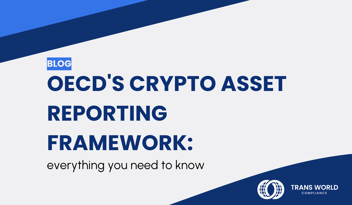The financial world is witnessing a major transformation as the OECD's Crypto Asset Reporting Framework (CARF) joins the established ranks of FATCA and CRS. With cryptocurrency transactions now under the same scrutiny as traditional banking, financial institutions and crypto investors are grappling with a new reality of comprehensive global tax transparency.
The Rise of CARF: Why Crypto Can No Longer Hide
CARF represents the first coordinated international effort to bring cryptocurrency transactions into the fold of automatic tax information exchange. Unlike its predecessors, CARF doesn't focus on account balances but instead on the granular details of crypto transactions themselves.
This shift is significant. Where CRS tracks how much money sits in your foreign bank account, CARF tracks every time you convert Bitcoin to Ethereum, cash out crypto for dollars, or receive staking rewards. The framework captures crypto-to-fiat exchanges, crypto-to-crypto swaps, and even peer-to-peer transfers above certain thresholds.
CARF also introduces reporting requirements for Reportable Retail Payment Transactions (purchases made using crypto assets that exceed $50,000). This expands the scope of reporting beyond exchanges and rewards to include real-world spending activity, making the framework even more comprehensive.
CARF is really meant to complement CRS; it's a very similar type of reporting but is meant to track these crypto transactions. The emphasis on transaction tracking rather than balance reporting creates an entirely different compliance landscape.
How FATCA Pioneered Global Tax Transparency
To understand the significance of CARF, we need to examine how we arrived at this point. FATCA broke new ground in 2010 by requiring foreign financial institutions to report on US taxpayers. The law expanded the definition of reportable entities far beyond traditional banks to include insurance companies, mutual funds, and eventually cryptocurrency exchanges.
FATCA deputized foreign financial institutions to report to the United States government regarding its holders which, essentially, turned every foreign bank into an arm of the IRS, creating unprecedented global tax transparency for US citizens.
FATCA's success in capturing previously hidden offshore accounts demonstrated the power of automatic information exchange and laid the groundwork for broader international cooperation through CRS.
CRS: The Multilateral Evolution
While FATCA focused on US taxpayers, CRS expanded the concept globally. CRS was launched by the OECD in 2014, and it enables automatic exchange of financial account information between over 100 participating countries. CRS creates a multilateral web of information sharing, unlike FATCA's bilateral approach.
The difference lies in the flexibility of enforcement. On one hand, FATCA imposes rigid compliance requirements with severe penalties; on the other, CRS allows participating countries to adapt the framework to their local regulatory environments. Although this flexibility has encouraged broader adoption, it has also created implementation variations that complicate global compliance strategies.
The CARF Integration Challenge
CARF enters this complex regulatory environment with its own unique characteristics. The framework's focus on transaction details, rather than account balances, creates both opportunities and challenges for tax planning and compliance; it means that information isn't directly captured, requiring additional reporting mechanisms or creative compliance solutions.
The decentralized nature of cryptocurrency adds another layer of complexity. Many crypto transactions occur outside traditional financial institutions through decentralized exchanges, peer-to-peer platforms, and self-custody wallets, which creates reporting gaps that regulators are still working to address.
Real-World Impact on Financial Institutions
The convergence of CARF, FATCA, and CRS is forcing financial institutions to rethink their entire compliance infrastructure. Traditional banks now find themselves reporting on crypto-related services they offer, while crypto-native companies must deal with complex international tax frameworks for the first time.
Additionally, the technical challenges are substantial. Tracking crypto transactions requires different systems and expertise that traditional account monitoring didn’t. Institutions must identify which transactions trigger reporting obligations, determine customer tax residencies across multiple jurisdictions, and maintain detailed transaction logs that can withstand regulatory scrutiny.
These requirements come at a time when the crypto industry is still defining basic operational standards.
The Regulatory Balancing Act
The introduction of CARF reflects regulators' efforts to strike a balance between innovation and oversight. An overly heavy-handed approach could stifle crypto innovation, while a too lenient framework might enable tax evasion and money laundering.
Early implementations of CARF suggest regulators are taking a measured approach, focusing first on centralized exchanges and major service providers before expanding to more decentralized platforms, allowing the industry to adapt while maintaining regulatory momentum.
It is clear that the success of this balancing act will largely determine the path of cryptocurrency's mainstream adoption. Clear, consistent regulatory frameworks, such as CARF, can provide the certainty that institutional investors and major corporations need to embrace digital assets fully.
Global Momentum Beyond CARF
Beyond CARF, major jurisdictions are moving fast. In Europe, MiCA (Markets in Crypto Assets) introduces mandatory registration for crypto-asset service providers, stablecoin regulation, and strong transparency rules. The Transfer of Funds Regulation now extends anti-money laundering (AML) and Know Your Customer (KYC) requirements for crypto transactions. Meanwhile, the US Congress is considering the GENIUS Act, which would create stablecoin-specific rules and may soon be enacted. As the EU and US establish clearer rules, confidence in the regulated adoption of crypto assets is growing.
New Era of Tax Transparency
As CARF takes its place alongside FATCA and CRS, we're entering an era of unprecedented global tax transparency. The combination of these three frameworks creates a comprehensive web of information sharing.
For financial institutions, this means developing integrated compliance strategies that address all three reporting requirements simultaneously. The days of treating crypto as a separate, unregulated frontier are over.
The ultimate impact of CARF will depend on its implementation and enforcement across different jurisdictions. Early adopters are already preparing their systems for rollouts, while others are taking a wait-and-see approach. What's clear is that the crypto industry's integration into the global financial system is accelerating, with all the opportunities and challenges that it entails.
The question isn't whether comprehensive crypto reporting will become the norm, but how quickly institutions can adapt to this new reality while maintaining their competitive edge in an increasingly regulated market.

David Olenzak
President and Founder of Trans World Compliance


